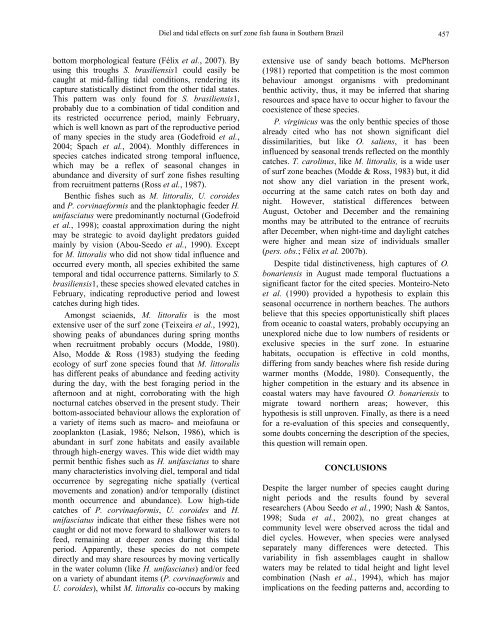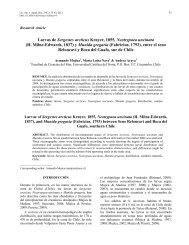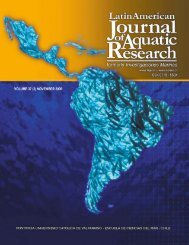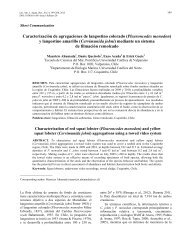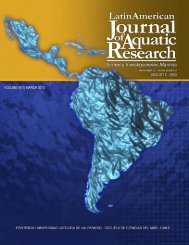Portada LAJAR.psd - Latin American Journal of Aquatic Research
Portada LAJAR.psd - Latin American Journal of Aquatic Research
Portada LAJAR.psd - Latin American Journal of Aquatic Research
You also want an ePaper? Increase the reach of your titles
YUMPU automatically turns print PDFs into web optimized ePapers that Google loves.
ottom morphological feature (Félix et al., 2007). By<br />
using this troughs S. brasiliensis1 could easily be<br />
caught at mid-falling tidal conditions, rendering its<br />
capture statistically distinct from the other tidal states.<br />
This pattern was only found for S. brasiliensis1,<br />
probably due to a combination <strong>of</strong> tidal condition and<br />
its restricted occurrence period, mainly February,<br />
which is well known as part <strong>of</strong> the reproductive period<br />
<strong>of</strong> many species in the study area (Godefroid et al.,<br />
2004; Spach et al., 2004). Monthly differences in<br />
species catches indicated strong temporal influence,<br />
which may be a reflex <strong>of</strong> seasonal changes in<br />
abundance and diversity <strong>of</strong> surf zone fishes resulting<br />
from recruitment patterns (Ross et al., 1987).<br />
Benthic fishes such as M. littoralis, U. coroides<br />
and P. corvinaeformis and the planktophagic feeder H.<br />
unifasciatus were predominantly nocturnal (Godefroid<br />
et al., 1998); coastal approximation during the night<br />
may be strategic to avoid daylight predators guided<br />
mainly by vision (Abou-Seedo et al., 1990). Except<br />
for M. littoralis who did not show tidal influence and<br />
occurred every month, all species exhibited the same<br />
temporal and tidal occurrence patterns. Similarly to S.<br />
brasiliensis1, these species showed elevated catches in<br />
February, indicating reproductive period and lowest<br />
catches during high tides.<br />
Amongst sciaenids, M. littoralis is the most<br />
extensive user <strong>of</strong> the surf zone (Teixeira et al., 1992),<br />
showing peaks <strong>of</strong> abundances during spring months<br />
when recruitment probably occurs (Modde, 1980).<br />
Also, Modde & Ross (1983) studying the feeding<br />
ecology <strong>of</strong> surf zone species found that M. littoralis<br />
has different peaks <strong>of</strong> abundance and feeding activity<br />
during the day, with the best foraging period in the<br />
afternoon and at night, corroborating with the high<br />
nocturnal catches observed in the present study. Their<br />
bottom-associated behaviour allows the exploration <strong>of</strong><br />
a variety <strong>of</strong> items such as macro- and mei<strong>of</strong>auna or<br />
zooplankton (Lasiak, 1986; Nelson, 1986), which is<br />
abundant in surf zone habitats and easily available<br />
through high-energy waves. This wide diet width may<br />
permit benthic fishes such as H. unifasciatus to share<br />
many characteristics involving diel, temporal and tidal<br />
occurrence by segregating niche spatially (vertical<br />
movements and zonation) and/or temporally (distinct<br />
month occurrence and abundance). Low high-tide<br />
catches <strong>of</strong> P. corvinaeformis, U. coroides and H.<br />
unifasciatus indicate that either these fishes were not<br />
caught or did not move forward to shallower waters to<br />
feed, remaining at deeper zones during this tidal<br />
period. Apparently, these species do not compete<br />
directly and may share resources by moving vertically<br />
in the water column (like H. unifasciatus) and/or feed<br />
on a variety <strong>of</strong> abundant items (P. corvinaeformis and<br />
U. coroides), whilst M. littoralis co-occurs by making<br />
Diel and tidal effects on surf zone fish fauna in Southern Brazil<br />
457<br />
extensive use <strong>of</strong> sandy beach bottoms. McPherson<br />
(1981) reported that competition is the most common<br />
behaviour amongst organisms with predominant<br />
benthic activity, thus, it may be inferred that sharing<br />
resources and space have to occur higher to favour the<br />
coexistence <strong>of</strong> these species.<br />
P. virginicus was the only benthic species <strong>of</strong> those<br />
already cited who has not shown significant diel<br />
dissimilarities, but like O. saliens, it has been<br />
influenced by seasonal trends reflected on the monthly<br />
catches. T. carolinus, like M. littoralis, is a wide user<br />
<strong>of</strong> surf zone beaches (Modde & Ross, 1983) but, it did<br />
not show any diel variation in the present work,<br />
occurring at the same catch rates on both day and<br />
night. However, statistical differences between<br />
August, October and December and the remaining<br />
months may be attributed to the entrance <strong>of</strong> recruits<br />
after December, when night-time and daylight catches<br />
were higher and mean size <strong>of</strong> individuals smaller<br />
(pers. obs.; Félix et al. 2007b).<br />
Despite tidal distinctiveness, high captures <strong>of</strong> O.<br />
bonariensis in August made temporal fluctuations a<br />
significant factor for the cited species. Monteiro-Neto<br />
et al. (1990) provided a hypothesis to explain this<br />
seasonal occurrence in northern beaches. The authors<br />
believe that this species opportunistically shift places<br />
from oceanic to coastal waters, probably occupying an<br />
unexplored niche due to low numbers <strong>of</strong> residents or<br />
exclusive species in the surf zone. In estuarine<br />
habitats, occupation is effective in cold months,<br />
differing from sandy beaches where fish reside during<br />
warmer months (Modde, 1980). Consequently, the<br />
higher competition in the estuary and its absence in<br />
coastal waters may have favoured O. bonariensis to<br />
migrate toward northern areas; however, this<br />
hypothesis is still unproven. Finally, as there is a need<br />
for a re-evaluation <strong>of</strong> this species and consequently,<br />
some doubts concerning the description <strong>of</strong> the species,<br />
this question will remain open.<br />
CONCLUSIONS<br />
Despite the larger number <strong>of</strong> species caught during<br />
night periods and the results found by several<br />
researchers (Abou Seedo et al., 1990; Nash & Santos,<br />
1998; Suda et al., 2002), no great changes at<br />
community level were observed across the tidal and<br />
diel cycles. However, when species were analysed<br />
separately many differences were detected. This<br />
variability in fish assemblages caught in shallow<br />
waters may be related to tidal height and light level<br />
combination (Nash et al., 1994), which has major<br />
implications on the feeding patterns and, according to


